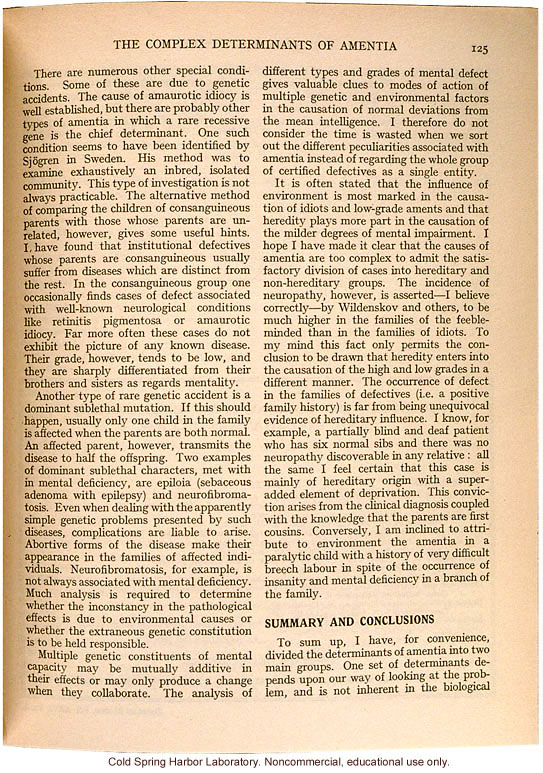The Complex Determinants of Amentia 125
There are numerous other special conditions. Some of these are due to genetic accidents. The cause of amaurotic idiocy is well established, but there are probably other types of amentia in which a rare recessive gene is the chief determinant. One such condition seems to have been identified by Sjogren in Sweden. His method was to examine exhaustively an inbred, isolated community. This type of investigation is not always practicable. The alternative method of comparing the children of consanguineous parents with those whose parents are unrelated, however, gives some useful hints. I have found that institutional defectives whose parents are consanguineous usually suffer from diseases which are distinct from the rest. In the consanguineous group one occasionally find cases of defect associated with well-known neurological conditions like retinitis pigmentosa or amaurotic idiocy. Far more often these dases do not exhibit the picture of any known disease. Their grade, however, tends to be low, and they are sharply differentiated from their brothers and sisters as regards mentality.
Another type of rare genetic accident is a dominant sublethal mutation. If this should happen, usually only one child in the family is affected when the parents are both normal. An affected parent, however, transmits the disease to half the offspring. Two examples of sublethal characters, met with in mental deficiency, are epiloia (sebaceous adenoma with epilepsy) and neurofibromatosis. Even when dealing with apparently simple genetic problems presented by such diseases, complications are liable to arise. Abortive forms of the disease make their appearance in the families of the affected individuals. Neurofibromatosis, for example, is not always associated with mental deficiency. Much analysis is required to determine whether the inconstancy in the pathological effects is due to environmental causes or whether the extraneous genetic constitution is to be held responsible.
Multiple genetic constituents of mental capacity may be mutually additive in their effects or may only produce a change when they collaborate. The analysis of different types and grades of mental defect gives valuable clues to modes of action of multiple genetic and environmental factors in the causation of normal deviations from the mean intelligence. I therefore do not consider the time is wasted when we sort out the different peculiarities associated with amentia instead of regarding the whole group of certified defectives as a single entity.
It is often stated that the influence of environment is most marked in the causation of idiots and low-grade aments and that heredity plays more part in the causation of the milder degrees of mental impairment. I hope I have made it clear that the causes of amentia are too complex to admit the satisfactory division of cases into hereditary and non-hereditary groups. The incidence of neuropathy, however, is asserted - I believe correctly - by Wildenskov and others, to be much higher in the families of the feeble-minded than in the families of idiots. To my mind this fact only permits the conclusion to be drawn that heredity enters into the causation of the high and low grades in a different manner. The occurrence of defect in the families of defectives (i.e. a positive family history) is far from being unequivocal evidence of hereditary influence. I know, for example, a partially blind and deaf patient who has six normal sibs and there was no neuropathy discoverable in any relative: all the same I feel certain that this case is mainly of hereditary origin with a super-added element of deprivation. This conviction arises from the clinical diagnosis coupled with the knowledge that the parents are first cousins. Conversely, I am inclined to attribute to environment the amentia in a paralytic child with a history of a very difficult breech labour in spite of the occurrence of insanity and mental deficiency in a branch of the family.
Summary and Conclusions
To sum up, I have, for convenience, divided the determinants of amentia into two main groups. One set of determinants depends upon our way of looking at the problem, and is not inherent in the biological
[end]


